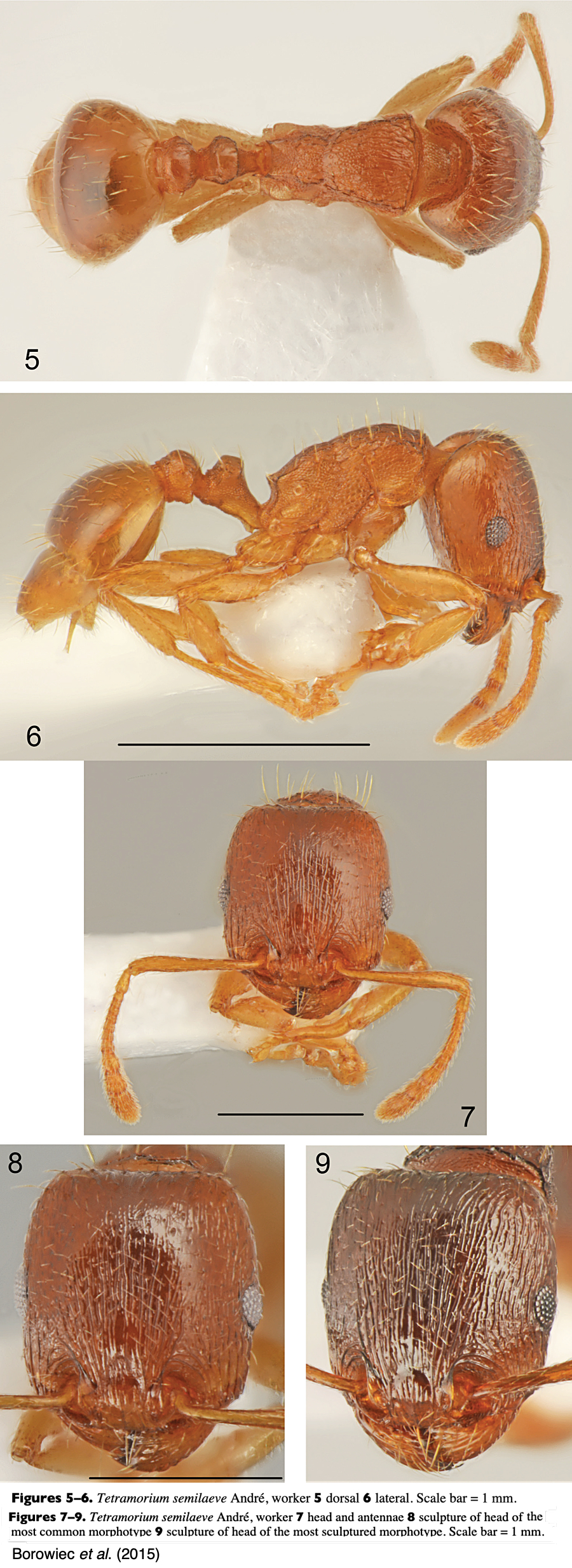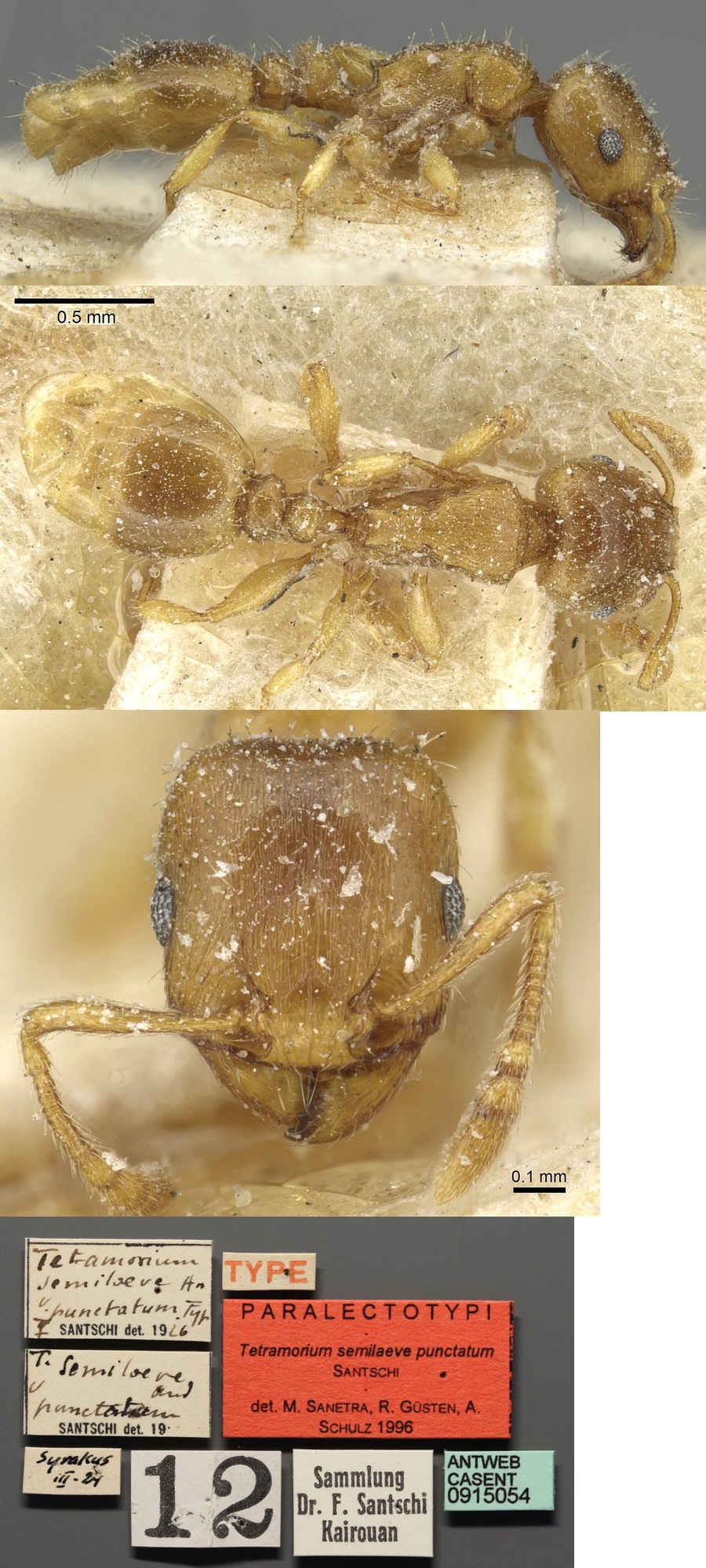| caespitum-group |
Tetramorium semilaeve (André)
 Type location Mediterranean
Region (Tetramorium caespitum var semilaeve, André,
1883a: 286, worker; Emery, 1891b: 2, queen; Forel, 1902a: 148, male;
raised to species first by Dalla Torre, 1893: 134; also Bondroit, 1918:
109) - no type images on Antweb (February, 2019). Type location Mediterranean
Region (Tetramorium caespitum var semilaeve, André,
1883a: 286, worker; Emery, 1891b: 2, queen; Forel, 1902a: 148, male;
raised to species first by Dalla Torre, 1893: 134; also Bondroit, 1918:
109) - no type images on Antweb (February, 2019).
Bolton (1995: 414) lists numerous subspecies but the
whole situation appears in great need of clear resolution.
|
 André's
(1883a) description is among the "Tetramorium
caespitum" varieties at André's
(1883a) description is among the "Tetramorium
caespitum" varieties at  Bondroit's (1918) note is at Bondroit's (1918) note is at  . .
Egypt records - Mohamed et al (2001,
illustrated);
Sharaf list - Material examined: Wadi El-Talaa, St.Catherine (South
Sinai), 15.xi.1998 (2); Wadi El-Talaa, St.Catherine (South Sinai),
19.ii.1998 (2); Wadi El-Arbaein, St.Catherine (South Sinai), 3.iv.1998
(8) (SHC); Sahab (South Sinai), 14.xi.1998 (1) Leg.M.R.Sharaf (ASUC).
This is somewhat similar to the Sinai specimens
collected by M James and diagnosed by BT as Tetramorium
schmidti but that clearly has more numerous erect hairs on the
alitrunk dorsum and is yellow.
|
 This was earlier diagnosed as Tetramorium
brevicorne by Mohamed et al (2001, illustrated) but the
paper by Sanetra, Güsten & Schulz (1999) shows that to have been an
error. Sanetra et al. found
that the scape length is not a reliable
distinction for separating workers from caespitum and the
sculpturation of the petiole nodes was a better characteristic. On brevicorne
the postpetiole has more or less evenly distributed reticulate
microsculpture; on caespitum this is restricted to, at the
most, the more basal part of the node; also the occiput on brevicorne
often has rugosity developed into a conspicuous arched pattern. This was earlier diagnosed as Tetramorium
brevicorne by Mohamed et al (2001, illustrated) but the
paper by Sanetra, Güsten & Schulz (1999) shows that to have been an
error. Sanetra et al. found
that the scape length is not a reliable
distinction for separating workers from caespitum and the
sculpturation of the petiole nodes was a better characteristic. On brevicorne
the postpetiole has more or less evenly distributed reticulate
microsculpture; on caespitum this is restricted to, at the
most, the more basal part of the node; also the occiput on brevicorne
often has rugosity developed into a conspicuous arched pattern.
References:
Borowiec, L., Galkowski, C. & Salata, S. 2015. What
is Tetramorium semilaeve
André, 1883? (Hymenoptera, Formicidae). ZooKeys, 512: 39–62 (2015). doi:
10.3897/zookeys.512.10006
Sanetra, M., Güsten, R., Schulz, A. 1999. On the
taxonomy and distribution of Italian Tetramorium
species and their social parasites (Hymenoptera Formicidae). Memorie della Societa Entomologica Italiana
77: 317–357.
|
 Borowiec
et al. (2015) had: Borowiec
et al. (2015) had:
Diagnosis. Tetramorium semilaeve
belongs to the group of Mediterranean species with workers
pale-coloured, from yellow to yellowish-brown but never dark brown or
black, head sculpture partly reduced, at least with postocular area and
sides of frons without distinct striation but with at least half of the
surface of the anterior part of head striate, striae on top of head not
diverging laterally, pronotum mostly striate, sides of mesosoma only
microreticulate and microgranulate without carinae, short propodeal
spines, petiole and postpetiole dorsally with polished area, and first
abdominal tergite smooth and shiny, without microreticulation or
striation.
Gyne with flat mesonotal plate, without a distinct striation or the
striation is indistinct, short not extending behind half length of the
plate, scutellum without striation or only on sides with short,
indistinct striae, postpetiole not enlarged; male genitalia stout, in
lateral view only slightly constricted before apex, ventral and dorsal
margins of parameres shallowly incised, top of inner margin of paramere
before apical denticle straight with dentiform plate distinctly clearly
extending beyond the sharp edge of paramere (Fig. 19, arrow indices
this plate, [male genitalia]). The presence of dentiform plate on top
of the inner margin of paramere is the best character distinguishing T. semilaeve from all other species
related to this taxon.
Their illustration (collected here) is of an unnamed specimen.
They cite also a "Lectotype worker (here designated, no.
ANTWEB1008880): Pyrénées Orientales, Type, MUSEUM PARIS
COLLECTION; ERNEST ANDRÉ, 1914, MNHN. There are no images of that on
CASENT (March 2019).
|
Oxford University Museum
specimens
Tetramorium semilaeve
B Taylor det.
|
Egypt
M Sharaf
|
8.iv.1998
Sinai
28°33' N
33°56' E
|
Wadi Arbaein
|
1
|
 |
|
 The
photomontage is of a worker from among those listed above as
collected by Mostafa Sharaf. Note the wholly smooth petiole and
postpetiole, whereas the head and dorsal alitrunk are finely but weakly
striate. The
photomontage is of a worker from among those listed above as
collected by Mostafa Sharaf. Note the wholly smooth petiole and
postpetiole, whereas the head and dorsal alitrunk are finely but weakly
striate.
|
 The photomontage
of
the punctatum type worker is collated from http://www.antweb.org/specimen.do?name=casent0915050. The photomontage
of
the punctatum type worker is collated from http://www.antweb.org/specimen.do?name=casent0915050.
Borowiec et al.
(2015) note that "Sanetra et al.
(1999) studied syntypes of this name, designated lectotype and raised
this taxon to species rank based on the morphology of workers, gynes
and electyrophoretic study. We agree with them, both taxa differ also
in structure of male genitalia", and, "We agree with them, in Sicily
occur two species from T. semilaeve
complex (the second one is T.
punctatum Santschi).
|
 The photomontage
of
the jugurtha type worker is collated from http://www.antweb.org/specimen.do?name=casent0915050. The photomontage
of
the jugurtha type worker is collated from http://www.antweb.org/specimen.do?name=casent0915050.
Described as Tetramorium
caespitum L. stirps semilaeve
Andre var. jugurtha n.v. by
Santschi 1921b: 430; as Tetramorium
semilaeve var. jugurtha
Sants. by Menozzi, 1934: 162;
type location Tunisia. Menozzi noted it as found all along the
Mediterranean coast of Africa.
Borowiec et al.
(2015) had "We have examined two syntypes from Tunisia available on
AntWeb (Available from: https://www.antweb.org/specimen/CASENT0904819
and https://www.antweb.org/specimen/CASENT0915050) and their characters
agree more with T. punctatum
than with T. semilaeve. At
this moment, we do not have any samples of T. semilaeve from North Africa and
Dalmatia. Both T. semilaeve
and T. punctatum occur in
Sicily and thus the conspecificity of “jugurtha”
with the true T. semilaeve is
not certain.
We agree that punctatum
and jugurtha are conspecific.
Our specimen as shown above is different, however. When images are
overlaid and adjusted so that the eye sizes match, our individual has a
distinctly longer alitrunk and a wider, longer head.
|
|